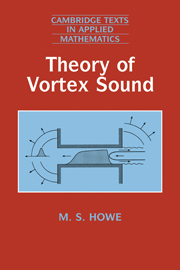2 - Lighthill's Theory
Published online by Cambridge University Press: 06 July 2010
Summary
The Acoustic Analogy
The sound generated by turbulence in an unbounded fluid is usually called aerodynamic sound. Most unsteady flows of technological interest are of high Reynolds number and turbulent, and the acoustic radiation is a very small byproduct of the motion. The turbulence is usually produced by fluid motion over a solid boundary or by flow instability. Lighthill (1952) transformed the Navier–Stokes and continuity equations to form an exact, inhomogeneous wave equation whose source terms are important only within the turbulent region. He argued that sound is a very small component of the whole motion and that, once generated, its back-reaction on the main flow can usually be ignored. The properties of the unsteady flow in the source region may then be determined by neglecting the production and propagation of the sound, a reasonable approximation if the Mach number M is small, and there are many important flows where the hypothesis is obviously correct, and where the theory leads to unambiguous predictions of the sound.
Lighthill was initially interested in solving the problem, illustrated in Fig. 2.1.1a, of the sound produced by a turbulent nozzle flow. However, his original theory actually applies to the simpler situation shown in Fig. 2.1.1b, in which the sound is imagined to be generated by a finite region of rotational flow in an unbounded fluid. This avoids complications caused by the presence of the nozzle.
- Type
- Chapter
- Information
- Theory of Vortex Sound , pp. 25 - 40Publisher: Cambridge University PressPrint publication year: 2002



